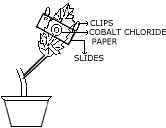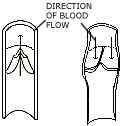(History) ICSE Class X Important Questions : Biology (2003)
Disclaimer: This website is NOT associated with CBSE, for official website of CBSE visit - www.cbse.gov.in
Paper : ICSE Class X Important Questions : Biology (2003)
General Instructions
- Attempt all questions from Section I and any four questions from Section II.
- The intended marks for questions or parts of questions are given in brackets.
SECTION I (40 Marks)
Attempt all questions from this Section.
Question 1
(a) Name the following: [8]
- The genetic constitution of an organism.**
- The tissue responsible for the ascent of sap in plants.
- The part of the eye responsible for its shape.
- The part of the chloroplast where the dark reaction of photosynthesis takes place.
- The kind of animal tissue found lining the respiratory organs.
- The gland in the skin that secretes sebum. **
- The pressure which is responsible for the movement of water molecules across the cortical cells of the root.
- The blood vessel which carries oxygenated blood to the liver.
(b) Given below in the box are a set of 22 biological terms. Of these, 18 can be paired into 9 matching pairs. Of the nine pairs, one has been done for you as an example. Write out the remaining 8 matching pairs. Number the pairs made by you as '1 to 8'. [8]
Cell wall, Deoxy ribonucleic dal, Neurotransmitter, Vaccine, Antibiotic, Weakened microbes, Melanin, Spinal cord, Adipose tissue, Cellulose, Chromosome, Adenosine triphosphate, Neuron, Subcutaneous layer, Penicillin, Energy molecule, Malphigian layer, Lysol, Liver, Acetylcholine, Kidney, Haemophilia.
Example: Adenosine triphosphate energy molecule.
(c) There are five groups given below with four examples in each. In each group, there is one example which does not fit into the category. For each of these groups write down the category of the group and identify the odd one as shown in the example below: [8]
- Diplococcus, Salmonella typhi, Plasmodium, Vibrio cholera.
- Adrenal, Liver, Thyroid, Pituitary.
- Coughing, Sneezing, Eating, Blinking.
- Corpus luteum, Corpus callosum, Pons, Cerebellum.
- Sulphur dioxide, Carbon monoxide, Oxygen, Nitrogen dioxide. Sl. No (i) has been done for you as an example. Example Sl. No. Category Odd one (i) Disease causing bacteria Plasmodium.
(d) Give the technical terms for the following: [8]
- Loss of water in the form of water droplets from the margin of leaves.
- A statistical study of the human population of a region.
- Air breathed in and out during quiet normal breathing.
- Movement of WBC 's out of capillary walls at the site of the injury.
- The period of intrauterine development of the embryo.
- A colourless plastid in the cytoplasm of plant cells around which starch collects.
- Proteins produced in the blood to fight and destroy harmful microbes.
- The phase of contraction of the chambers of the heart.
(e) Given below is an incomplete table relating to certain structures found in the human body, their location and function. Study the same and then give the appropriate answer in terms of structure, location and function, for the blanks numbered 1 to 8: [8]
| Structure | Location | Function |
| Epiglottis ...3... ...5... Yellow spot |
...1... ...4...the glands on top of the kidneys ...7... |
...2... insulates the Axon ...6... ...8... |
SECTION II (40 Marks)
Answer any four questions from this section.
Question 2
(a) Given alongside is the diagram of a part of the human ear. Study the same
and then answer the questions that follow: [5]

- Give the biological term for Malleus, Incus and Stapes.
- Name the parts labelled A, B and C in the diagram.
- State the functions of the parts labelled 'A' and 'B'.
- Name the audio receptor region present in the part labelled 'A'.
(b) A healthy croton plant bearing variegated leaves was kept in a dark cupboard to destarch it after which it was placed in sunlight for a few hours. One of the leaves was then plucked and an outline of the leaf marking the green and the non-green regions was drawn. The leaf was then tested for starch. Using the above information, answer the following questions: [5]
- State the aim of the above experiment.
- Name the chemical used for testing the presence of starch.
- Why is the leaf boiled in water and alcohol before testing for the presence of starch?
- What change is seen on the leaf after the starch test?
- Give the chemical equation to represent the process of starch formation in plants.
Question 3
(a) Given below is the diagram of an experimental set up to study the process of
transpiration in plants. Study the same and then answer the questions that
follow: [5]

- What is the colour of dry cobalt chloride paper?
- Is the experimental leaf a monocot or a dicot? Give a reason to support your answer.
- Why are glass slides placed over the dry cobalt chloride papers?
- After about half an hour what change, if any, would you expect to find in the cobalt chloride paper placed on the dorsal and ventral sides of the leaf ? Give a reason to support your answer.
- Define the term 'transpiration.'
(b) [5]
- Draw a neat diagram of a single Malphigian corpuscle and label the
following parts:
Glomerulus, Bowman's capsule, Afferent arteriole, and Efferent arteriole. - Name and define the process that occurs in the glomerulus.
Question 4
(a) [5]
- From where to where do the following blood vessels carry blood?
1. Hepatic vein. 2. Hepatic portal vein. - State any four major activities of the Red Cross Society.
- Define 'birth rate.'
(b) Differentiate between any five of the following: [5]
- Blood plasma and serum.
- Antiseptic and disinfectant.
- Catabolism and anabolism.
- Pleural fluid and pericardial fluid.
- Aerobic respiration and anaerobic respiration.
- Structure of the sperm and the structure of the ovum.
Question 5
(a) Given below is the outline of the cross section of the male reproductive
system:[5]

- Copy the outline on to your answer sheet in pencil and label the following parts-testis, epididymis, seminal vesicles, vas deference.
- Name the hormone produced by the testis.
- Why are sperms produced in large numbers?
- State the function of the seminal vesicles.
(b) Define the following terms, giving one example of each: [5]
- Alleles**
- Hormone
- Exocrine gland
- Active transport
- Gaseous pollutant.
Question 6
(a) The diagram below represents a certain category of blood vessels showing the
role of a special structure in their walls: [6]

- Name the kind of blood vessels shown.
- Name the structure shown inside the blood vessels.
- Describe the role of these structures.
- Are these structures present in any other kind of blood vessel? If so, name it.
- Towards which side of the figure (top or bottom) is the heart located?
(b) [5]
- What are the age restrictions for marriage by law for boys and girls in India?
- Name two surgical techniques (one for the human male and another for the human female) that can be used to prevent pregnancy in the female.
- Give two advantages of a small family.
Question 7
(a) Given below is a diagram representing a stage during mitotic cell division
in an animal cell.** [5]

- Identify the above stage. Give a reason to support your answer.
- Name the cell organelle that forms the 'aster'.
- Name the parts labelled 1, 2 and 3.
- Name the stage that follows this stage of mitosis. How can this stage be identified?
- Mention two points of difference between 'mitosis' and 'meiosis' with
regard to:
1. The number of daughter cells formed. 2. The chromosome number in the daughter cells.
(b) Give one reason for each of the following: [5]
- Wilted lettuce leaves d kept in cold water become crisp.
- It is advisable not to sleep under a tree at night.
- Urine is slightly thicker in summer than in winter.
- Erythrocytes are biconcave discs and lack mitochondria.
- Noise is regarded as unwanted sound.